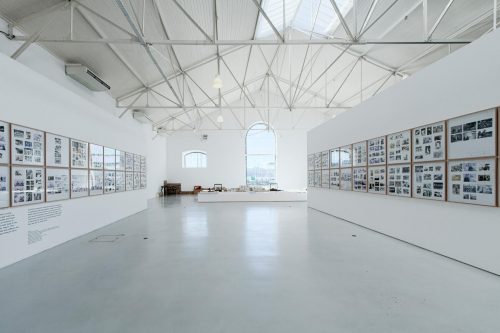The Avenida da Índia Gallery is located in Bom Sucesso, an area of Belém so named for an ancient monastery located there. The gallery building is part of an urban industrial nucleus dating back to the 19th century. In around 1819-21, João Baptista Ângelo da Costa established the National Factory of Steam Machines in the area, giving rise to the Bom Sucesso Milling Factory (1884), located near the port with the same name.
In 1909, José António dos Reis, owner of the Milling Factory and the land it occupied, ordered the construction of new warehouses designated by the letters B, C and D – currently occupied by the Avenida da Índia Gallery (at number 170), Karnart (number 168) and the Lisbon Archaeology Centre (number 166). In the 1920s, the manufacturing infrastructure in Bom Sucesso became the property of Companhia Industrial de Portugal e Colónias, which operated there until the late 1930s. When the Company moved to Beato in the eastern part of Lisbon, the industrial facilities of Bom Sucesso were put up for sale. The set of buildings next to Avenida da Índia was then acquired by the Lisbon City Council (CML), establishing the western boundary of the 1940 Portuguese World Exhibition.
Following a fire in their workshops on 13 July 1972 (in the old Pavilion of Independence from the Portuguese World Exhibition, near the Belém River Station), the artists Maria Helena Matos, António Cândido dos Reis, Carlos Amado and António Augusto Lagoa Henriques moved to the old block of factory warehouses. The formal transfer of 168 Avenida da Índia – formerly warehouse C – from the CML took place in 1978-80 and the space was compartmentalised to rehouse these artists’ workshops.
Until his death in February 2009, the sculptor Lagoa Henriques acted as a tutelary figure within the space (which was also known as “Lagoa Henriques’s Universe”). In 2001, the CML struck an agreement with Lagoa Henriques for the creation of an atelier/museum at 170 Avenida da Índia, formerly warehouse B. It is there that the Avenida da Índia Gallery currently operates, recovered by EGEAC in 2015 and inaugurated by the Municipal Galleries in November of that same year. It opened to the public with the initiative “Retornar – Traços de Memória” (Return – Traces of Memory), which marked the 40th anniversary of the 1975 air bridge between Portugal and its former colonies.



